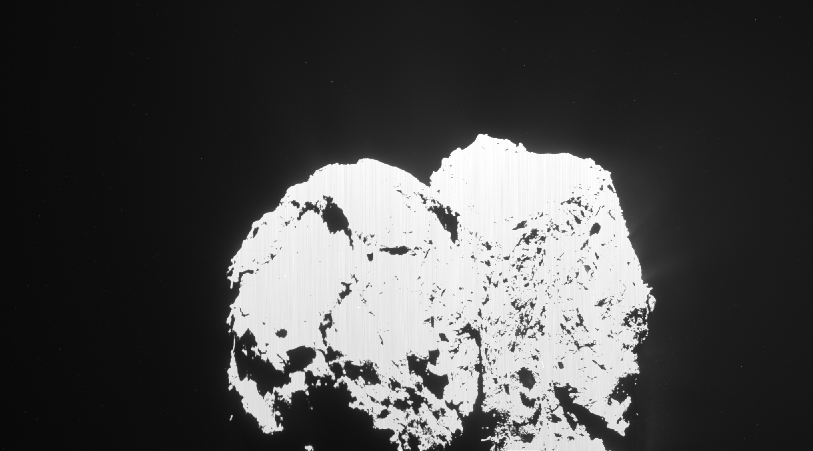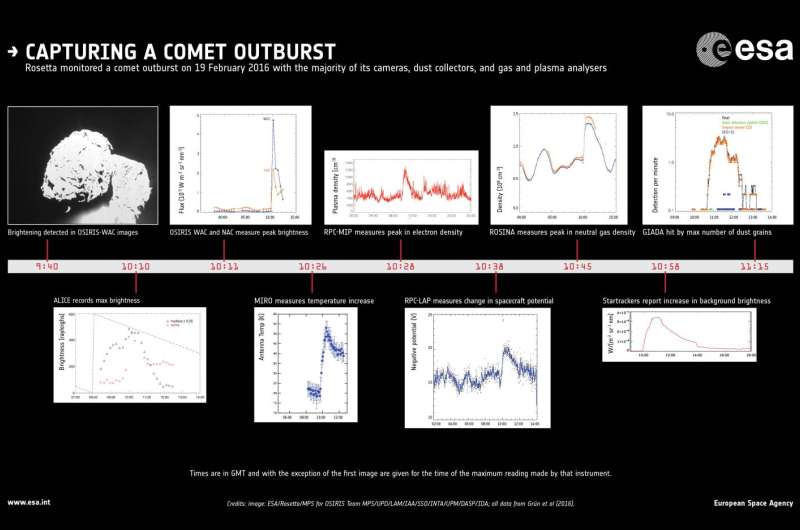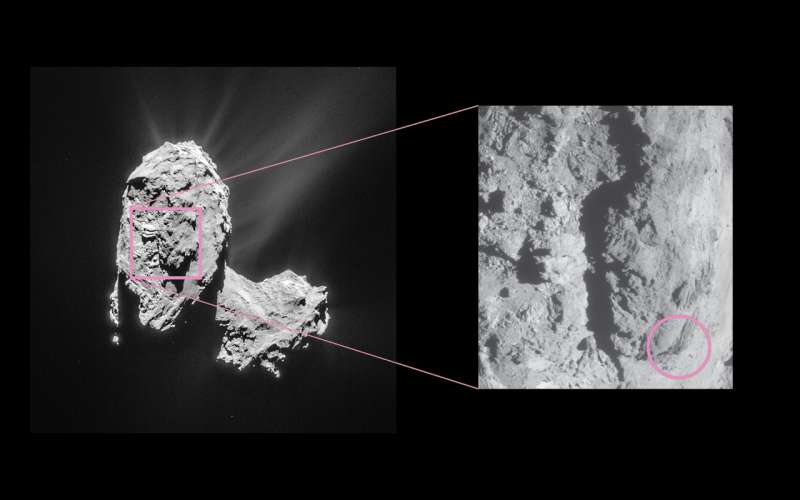Rosetta captures comet outburst

In unprecedented observations made earlier this year, Rosetta unexpectedly captured a dramatic comet outburst that may have been triggered by a landslide.
Nine of Rosetta's instruments, including its cameras, dust collectors, and gas and plasma analysers, were monitoring the comet from about 35 km in a coordinated planned sequence when the outburst happened on 19 February.
"Over the last year, Rosetta has shown that although activity can be prolonged, when it comes to outbursts, the timing is highly unpredictable, so catching an event like this was pure luck," says Matt Taylor, ESA's Rosetta project scientist.
"By happy coincidence, we were pointing the majority of instruments at the comet at this time, and having these simultaneous measurements provides us with the most complete set of data on an outburst ever collected."
The data were sent to Earth only a few days after the outburst, but subsequent analysis has allowed a clear chain of events to be reconstructed, as described in a paper led by Eberhard Grün of the Max-Planck-Institute for Nuclear Physics, Heidelberg, accepted for publication in Monthly Notices of the Royal Astronomical Society.
A strong brightening of the comet's dusty coma was seen by the OSIRIS wide-angle camera at 09:40 GMT, developing in a region of the comet that was initially in shadow.
Over the next two hours, Rosetta recorded outburst signatures that exceeded background levels in some instruments by factors of up to a hundred. For example, between about 10:00–11:00 GMT, ALICE saw the ultraviolet brightness of the sunlight reflected by the nucleus and the emitted dust increase by a factor of six, while ROSINA and RPC detected a significant increase in gas and plasma, respectively, around the spacecraft, by a factor of 1.5–2.5.

In addition, MIRO recorded a 30ºC rise in temperature of the surrounding gas.
Shortly after, Rosetta was blasted by dust: GIADA recorded a maximum hit count at around 11:15 GMT. Almost 200 particles were detected in the following three hours, compared with a typical rate of 3–10 collected on other days in the same month.
At the same time, OSIRIS narrow-angle camera images began registering dust grains emitted during the blast. Between 11:10 GMT and 11:40 GMT, a transition occurred from grains that were distant or slow enough to appear as points in the images, to those either close or fast enough to be captured as trails during the exposures.
In addition, the startrackers, which are used to navigate and help control Rosetta's attitude, measured an increase in light scattered from dust particles as a result of the outburst.
The startrackers are mounted at 90º to the side of the spacecraft that hosts the majority of science instruments, so they offered a unique insight into the 3-D structure and evolution of the outburst.
Astronomers on Earth also noted an increase in coma density in the days after the outburst.
By examining all of the available data, scientists believe they have identified the source of the outburst.

"From Rosetta's observations, we believe the outburst originated from a steep slope on the comet's large lobe, in the Atum region," says Eberhard.
The fact that the outburst started when this area just emerged from shadow suggests that thermal stresses in the surface material may have triggered a landslide that exposed fresh water ice to direct solar illumination. The ice then immediately turned to gas, dragging surrounding dust with it to produce the debris cloud seen by OSIRIS.
"Combining the evidence from the OSIRIS images with the long duration of the GIADA dust impact phase leads us to believe that the dust cone was very broad," says Eberhard.
"As a result, we think the outburst must have been triggered by a landslide at the surface, rather than a more focused jet bringing fresh material up from within the interior, for example."
"We'll continue to analyse the data not only to dig into the details of this particular event, but also to see if it can help us better understand the many other outbursts witnessed over the course of the mission," adds Matt.
"It's great to see the instrument teams working together on the important question of how cometary outbursts are triggered."
More information: "The 19 Feb. 2016 outburst of comet 67P/CG: A Rosetta multi-instrument study," by E. Grün et al is published in the Monthly Notices of the Royal Astronomical Society. DOI: 10.1093/mnras/stw2088
Journal information: Monthly Notices of the Royal Astronomical Society





















